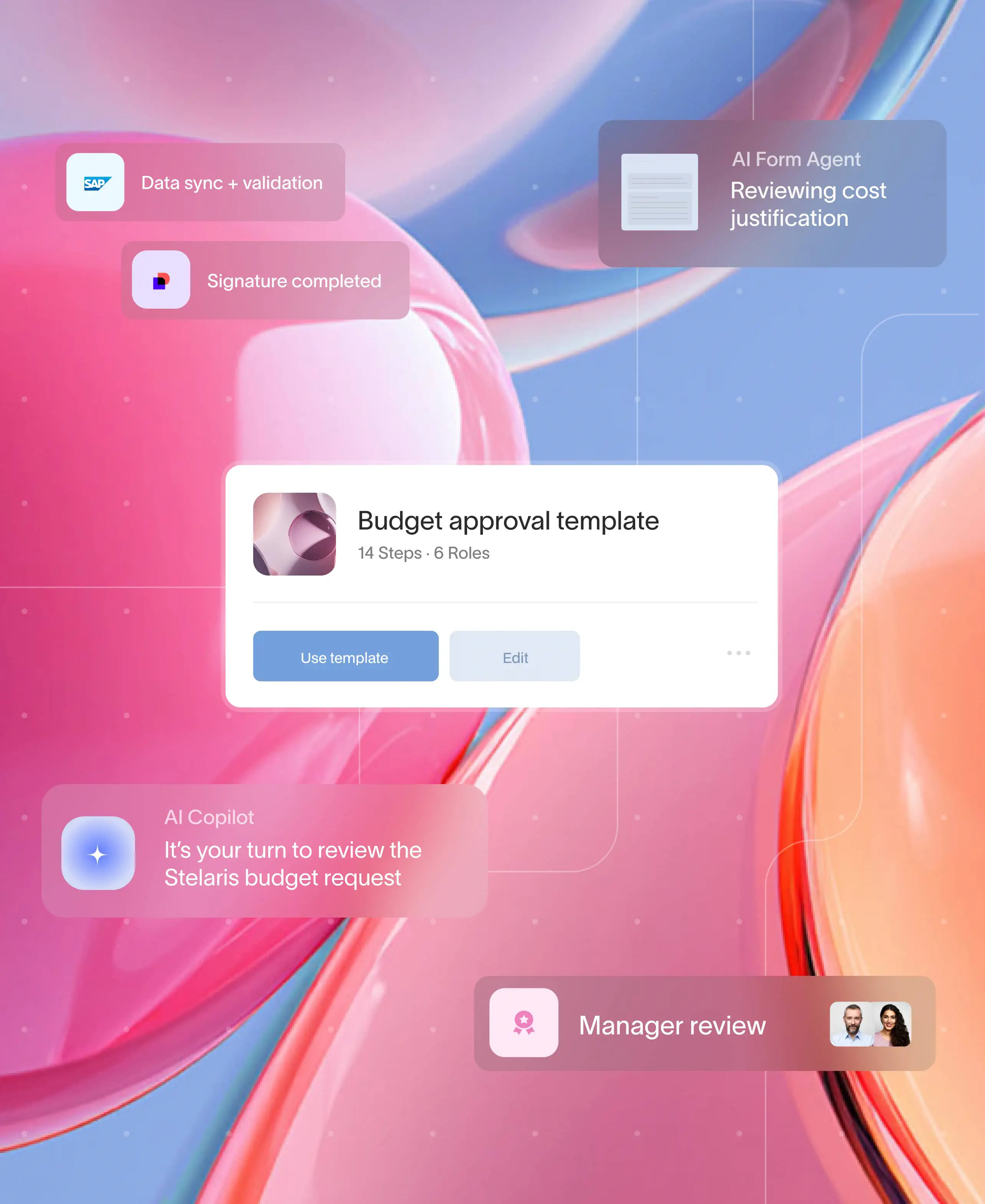
At a glance
Contracts should accelerate business, but for many organizations, they do the opposite. Deals stall for weeks waiting on signatures, renewals slip through the cracks, and teams waste hours reconciling different versions of the same document. Inefficiency in contract management doesn’t just frustrate employees — it impacts revenue, compliance, and client trust.
McKinsey found that organizations with efficient contract workflows can reduce contracting time by up to 60%, freeing up capital sooner and boosting client satisfaction. Efficiency is not just about speed. It’s about reducing operational risk, projecting professionalism, and making sure contracts support growth rather than stall it.
In this article, we’ll explore what an efficient contract workflow looks like, why it matters commercially, and how businesses can implement practices that save time, reduce risk, and create better client experiences. For the broader framework, see our guide to contract management workflow.
The cost of inefficiency
Before we define what efficiency looks like, it’s important to understand the stakes. Inefficient contract processes drain resources and erode value:
- Revenue leakage. WorldCC estimates companies lose the equivalent of 9% of annual revenue due to poor contract practices — often caused by missed renewals and negotiation delays.
- Lost deals. A client who waits weeks for a contract to be finalized may sign with a competitor instead.
- Compliance exposure. According to Gartner, failure to maintain proper contract controls can increase regulatory fines by 20–30%.
- Wasted staff time. EY reports contract managers spend more than 30% of their time on admin tasks like chasing approvals — time that could be spent advising the business.
The bottom line: inefficiency in contract management is not a minor operational issue. It’s a direct drag on profitability and reputation.
The anatomy of an efficient contract workflow
An efficient contract workflow is not just about moving faster — it’s about orchestrating clarity, accountability, and collaboration. Here are the hallmarks:
1. Clear ownership
Every stage of the workflow defines who is responsible. Drafting belongs to account managers, legal owns compliance checks, and executives sign off on terms. This eliminates ambiguity and prevents contracts from stalling in inboxes.
2. Consistency through templates
Contracts begin with standardized, pre-approved templates. This reduces drafting errors and negotiation time, while ensuring compliance with company policies.
3. Automated approvals
Approvals are routed automatically to the right stakeholders. Intelligent nudges remind people when it’s their turn, and escalations prevent bottlenecks if someone doesn’t respond.
4. Client-facing collaboration
External parties can review, redline, and sign contracts in a secure portal. This eliminates version chaos caused by emailing PDFs back and forth.
5. Audit-ready tracking
Every change, approval, and signature is logged. This provides visibility for leadership and protects the business during audits or disputes.
6. Integrated systems
Efficient workflows connect to CRMs, procurement tools, and finance systems. Data flows seamlessly, avoiding duplicate entry and errors.
When these elements come together, contracts stop being bottlenecks and start becoming business accelerators.
Why efficiency matters commercially
Accelerated revenue
Contracts gate revenue. An efficient workflow means agreements are signed and executed quickly, enabling faster billing and recognition.
Reduced risk
Audit trails and role-based approvals prevent unauthorized decisions and strengthen compliance.
Improved client experience
Clients notice when contracts drag on. A professional, streamlined workflow makes doing business easy and builds trust.
Operational savings
IDC reports that automation reduces contract processing costs by 25–30%, freeing up staff to focus on growth.
What inefficiency looks like in practice
Inefficient workflows are easy to recognize:
- Missed renewals. Without tracking, contracts lapse unnoticed, disrupting supply chains or revenue streams.
- Lost deals. Clients lose patience waiting for contracts to clear internal hurdles.
- Compliance gaps. Missing approvals or undocumented changes leave businesses vulnerable in audits.
- Staff burnout. Employees spend valuable time chasing signatures instead of closing new business.
These issues are avoidable with an orchestrated workflow.
Real-world examples of efficiency
Financial services. A bank implementing efficient workflows cut loan agreement turnaround time by 45%, allowing faster client onboarding and reduced compliance risk.
Legal services. A mid-sized law firm adopted standardized templates and role-based approvals. The time spent on client retainers dropped by half, and client satisfaction scores rose.
Procurement. A global manufacturer automated supplier contract renewals, reducing compliance gaps and saving more than 1,000 staff hours annually.
Professional services. A consulting firm orchestrated client agreements with client-facing collaboration. Negotiation time fell by 30%, and client onboarding started sooner.
For another practical illustration, see our contract management example.
What to look for in an efficient workflow platform
Efficiency requires more than digitization. Businesses should look for solutions that deliver:
- Client-facing collaboration so external parties can review, redline, and sign securely.
- Audit-ready logs capturing every approval and change.
- Automated routing and reminders to keep contracts moving.
- Templates and role-based permissions for consistency.
- Integration with CRMs and finance systems to reduce silos.
Moxo’s workflow orchestration platform was designed for these multi-party workflows. By combining automation, auditability, and client-facing collaboration, it ensures contracts move smoothly from draft to renewal.
Best practices for efficient workflows
Standardize your templates
Avoid reinventing the wheel every time. Standardization ensures consistency, reduces negotiation friction, and improves compliance.
Automate escalations
Approvals should never sit idle. Build in escalation paths so stalled tasks move to alternate approvers after a set timeframe.
Track and refine cycle times
Measure where contracts stall. Use this data to refine processes continuously and eliminate bottlenecks.
Engage clients directly
Provide clients with a secure, branded experience for reviewing and signing. It reduces friction and improves professionalism.
Plan for renewals early
Trigger reminders well in advance — often 90 days before expiration — to avoid revenue leakage and compliance risks.
These practices align closely with building an efficient contract workflow that scales as your business grows.
Frequently asked questions
What makes a contract workflow efficient
Clarity of ownership, standardized templates, automated approvals, audit-ready logs, and client-facing collaboration.
How does efficiency impact revenue
Efficient workflows shorten cycle times, enabling faster revenue recognition and reducing lost opportunities.
How do efficient workflows impact renewals
They ensure milestones are tracked, reminders are triggered, and opportunities for renewal are never missed.
How does efficiency differ from contract lifecycle management (CLM)
CLM systems often focus on storage and compliance. Efficient workflows go further by orchestrating real-time actions and collaboration that move contracts forward.
Do small businesses benefit from efficiency
Yes. Even organizations with modest contract volumes save time, reduce risk, and project professionalism by adopting efficient workflows.
Why efficiency matters more than ever
Contracts aren’t just legal documents — they are business-critical touchpoints. Inefficiency delays revenue, creates compliance risk, and frustrates clients. By contrast, an efficient contract workflow accelerates business, builds trust, and protects the bottom line.
Moxo enables organizations to orchestrate efficient contract workflows end-to-end. Book a 15 minute demo and discover how Moxo can help you turn contracts into a growth driver.





